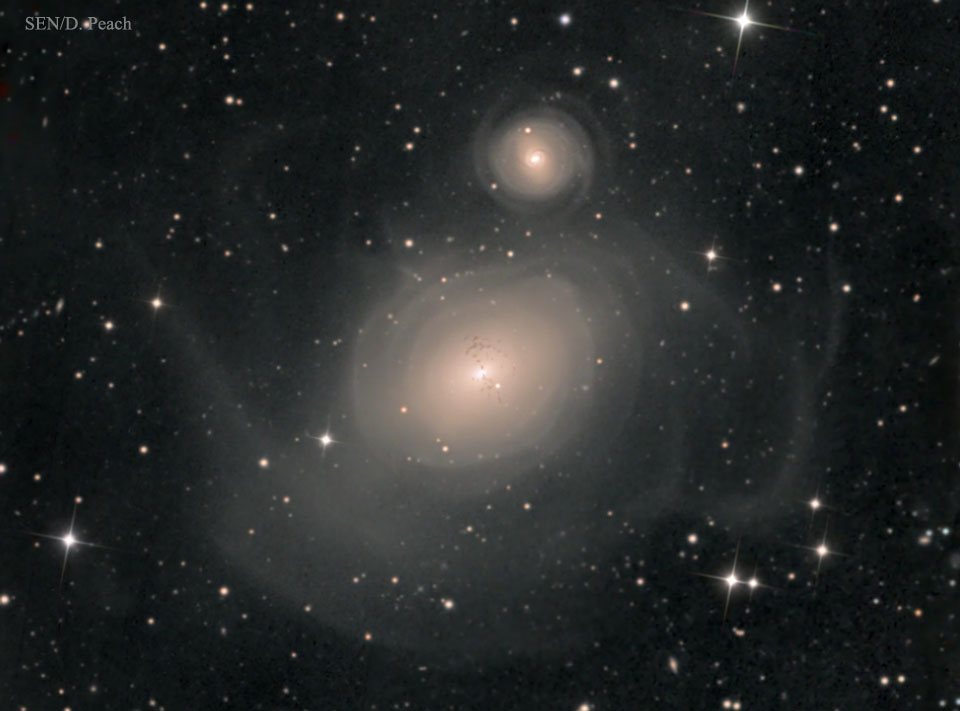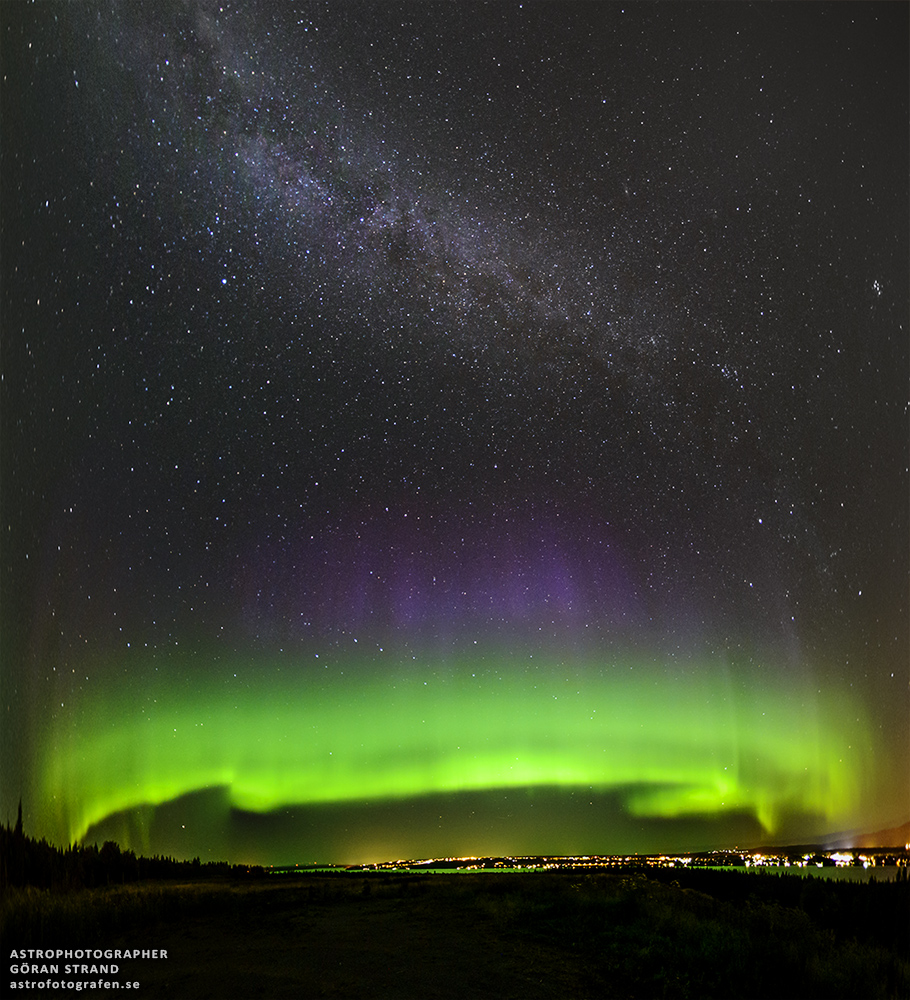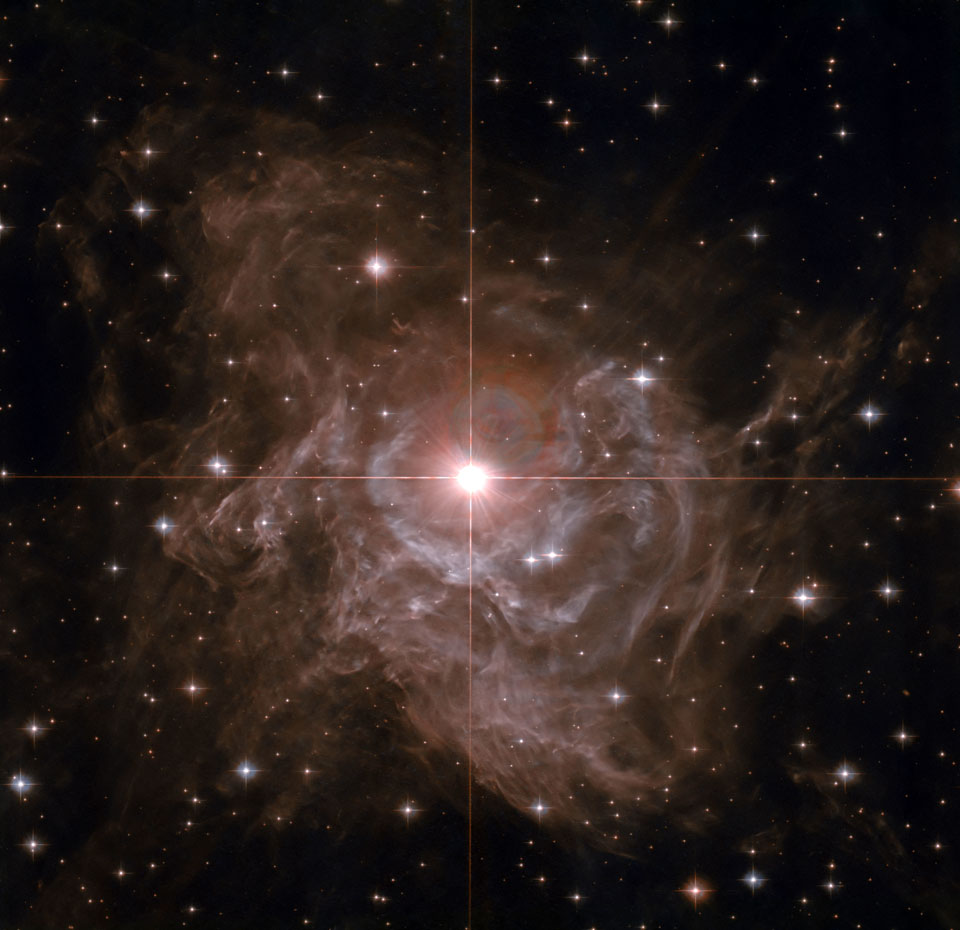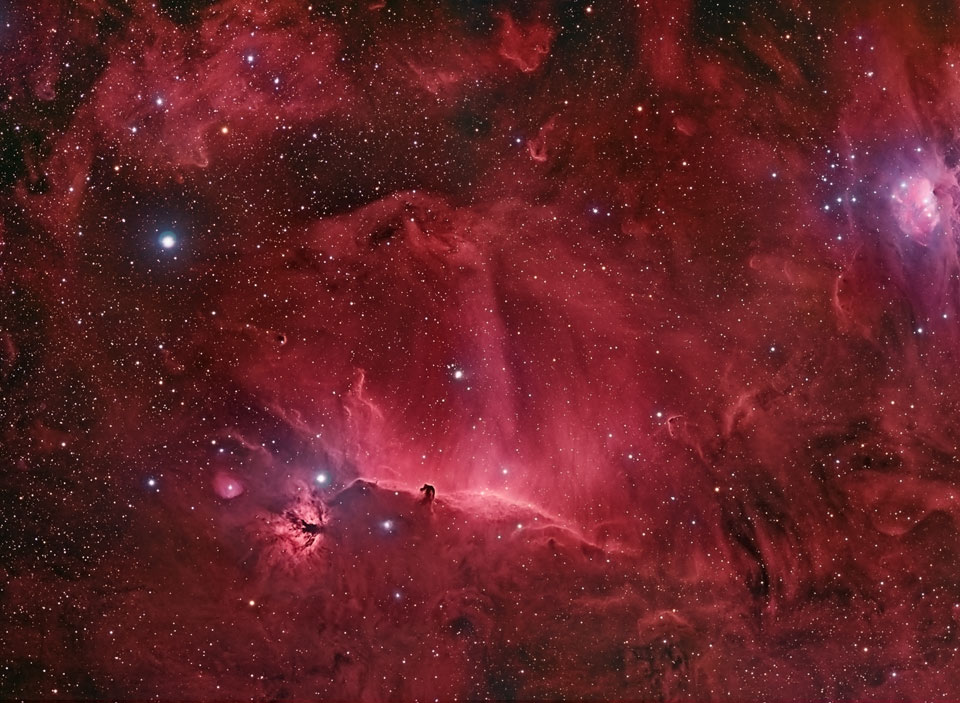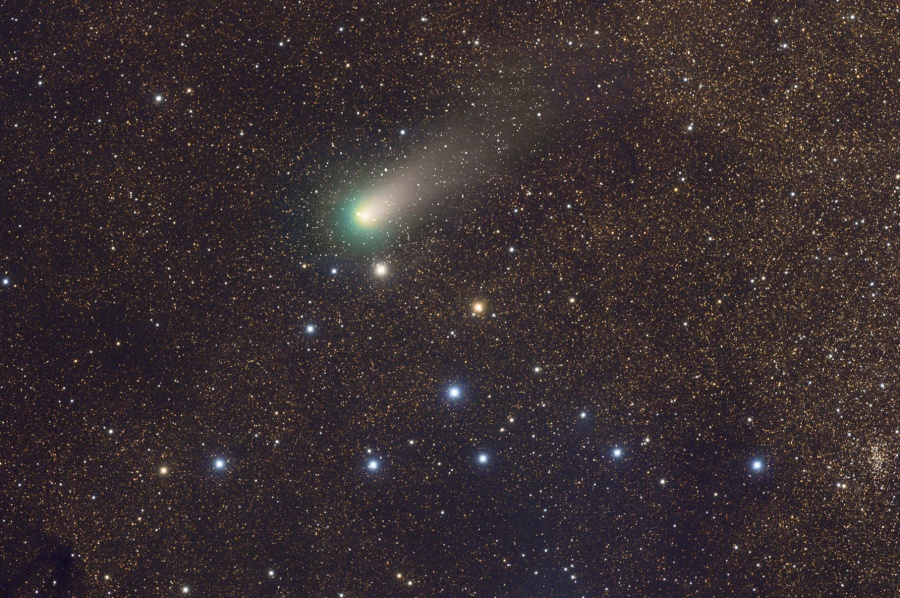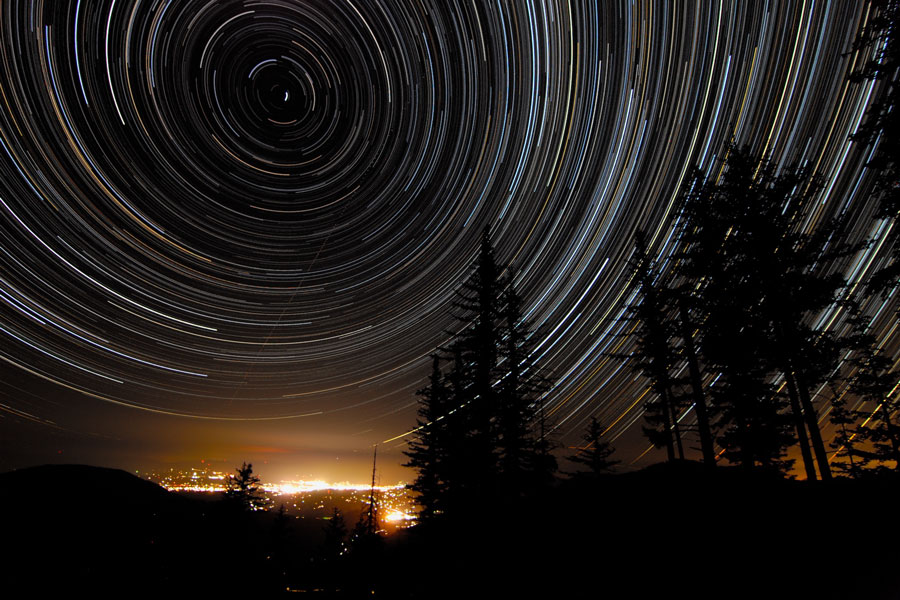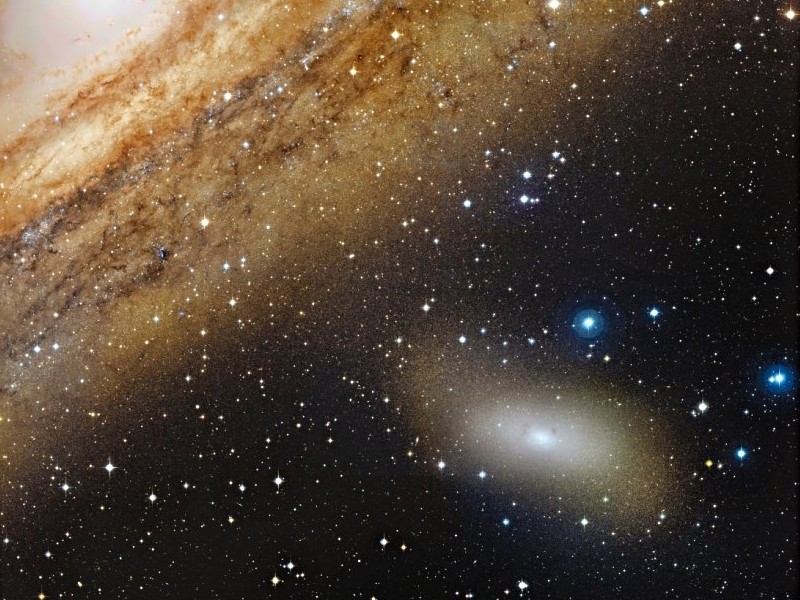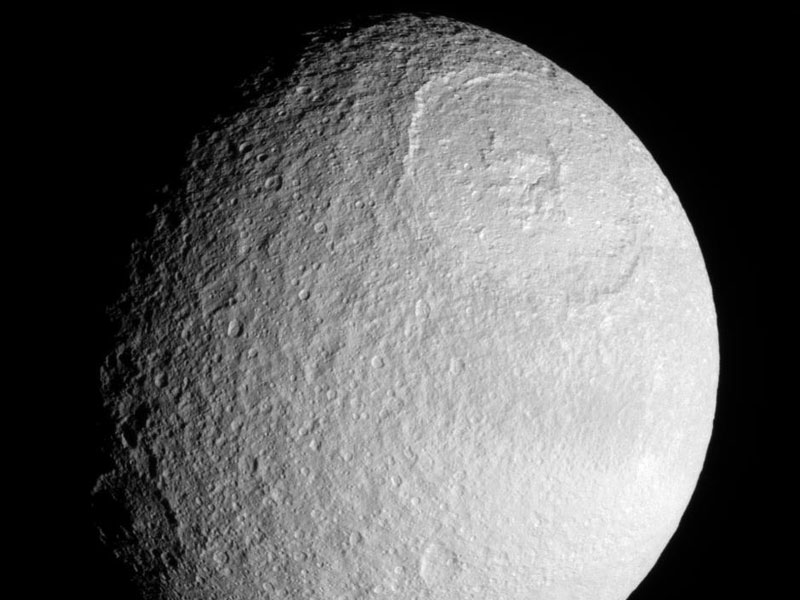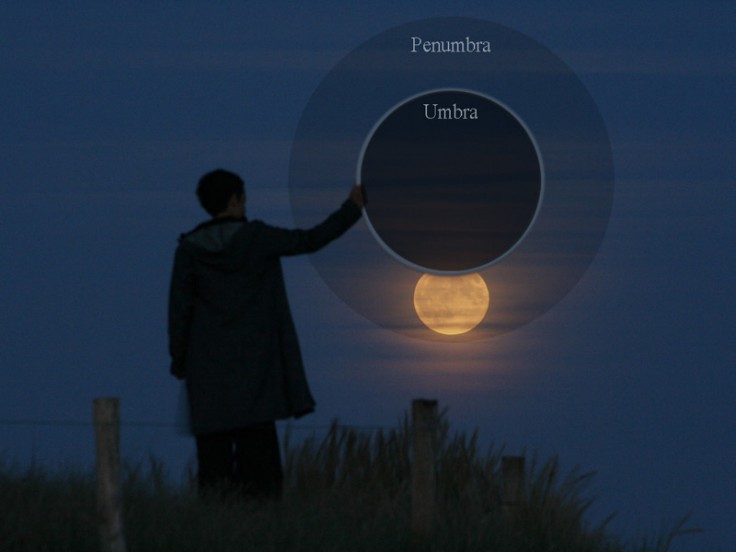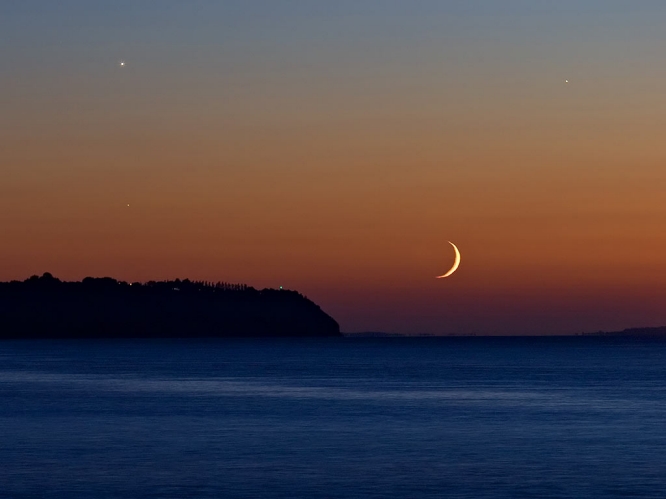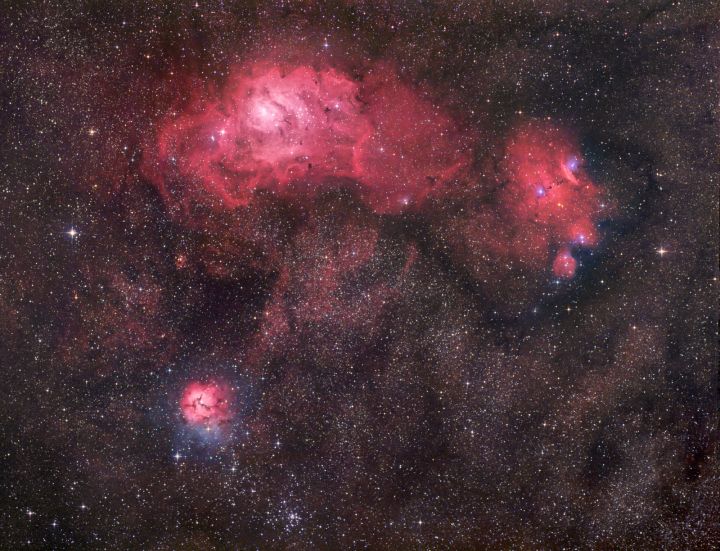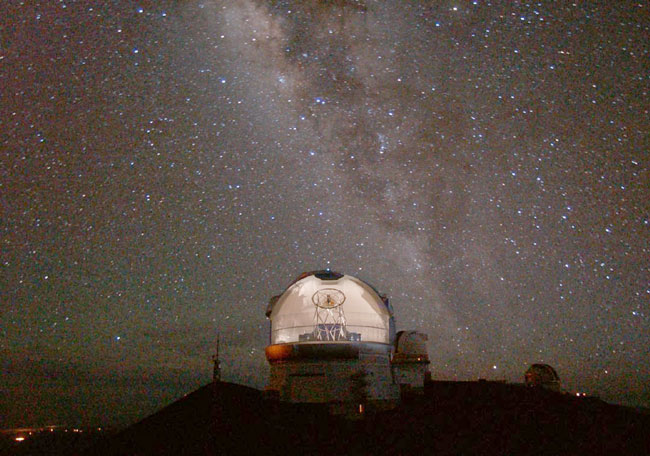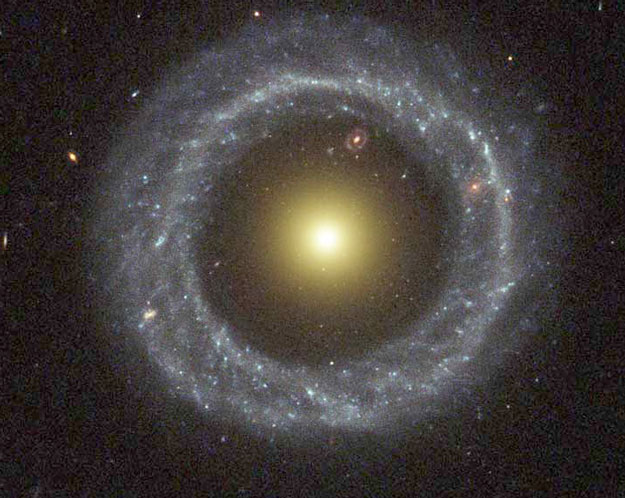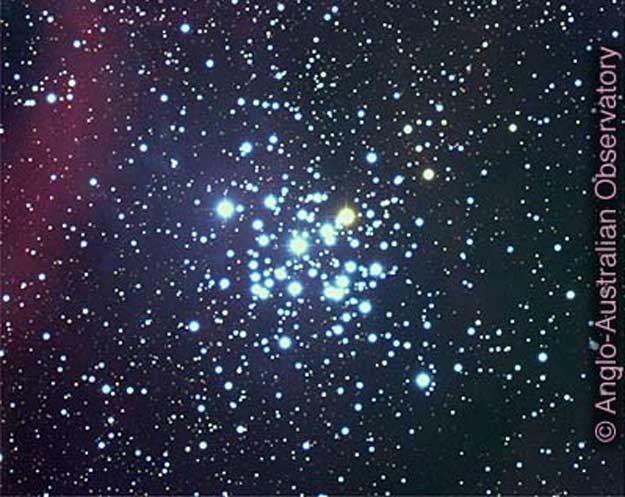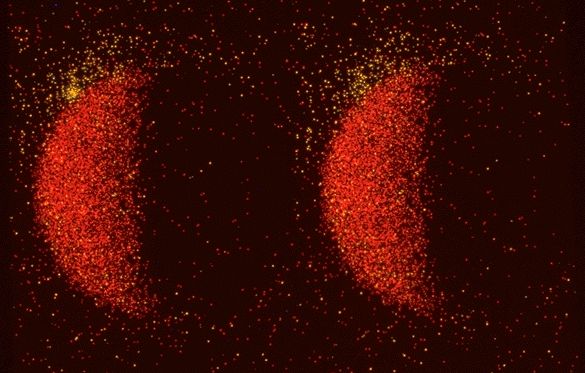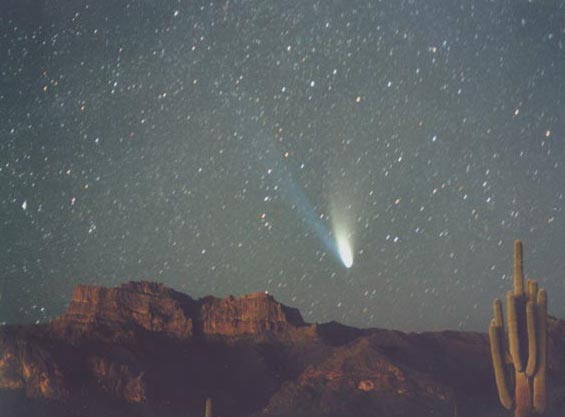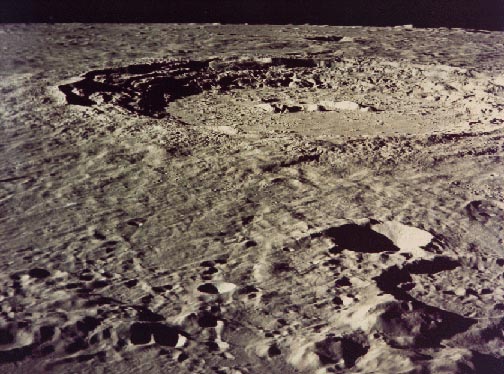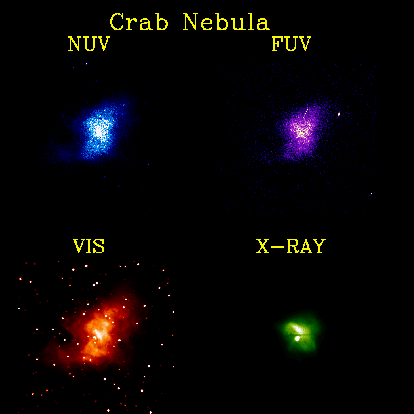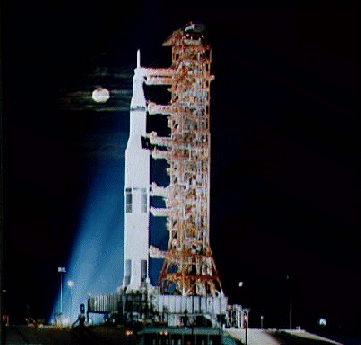| << Previous | Index | Next >> |
2015 Astronomers turn detectives when trying to figure out the cause of startling sights like NGC 1316. Their investigation indicates that NGC 1316 is an enormous elliptical galaxy that started, about 100 million years ago, to devour a smaller spiral galaxy neighbor, NGC 1317, just above it. Supporting evidence includes the dark dust lanes characteristic of a spiral galaxy, and faint swirls and shells of stars and gas visible in this wide and deep image. One thing that remains unexplained is the unusually small globular star clusters, seen as faint dots on the image. Most elliptical galaxies have more and brighter globular clusters than NGC 1316. Yet the observed globulars are too old to have been created by the recent spiral collision. One hypothesis is that these globulars survive from an even earlier galaxy that was subsumed into NGC 1316. Another surprising attribute of NGC 1316, also known as Fornax A, is its giant lobes of gas that glow brightly in radio waves.
2014 This sky looked delicious. Double auroral ovals were captured above the town lights of Östersund, Sweden, last week. Pictured above, the green ovals occurred lower to the ground than violet aurora rays above, making the whole display look a bit like a cupcake. To top it off, far in the distance, the central band or our Milky Way Galaxy slants down from the upper left. The auroras were caused by our Sun ejecting plasma clouds into the Solar System just a few days before, ionized particles that subsequently impacted the magnetosphere of the Earth. Aurora displays may continue this week as an active sunspot group rotated into view just a few days ago.
2013 It is one of the most important stars in the sky. This is partly because, by coincidence, it is surrounded by a dazzling reflection nebula. Pulsating RS Puppis, the brightest star in the image center, is some ten times more massive than our Sun and on average 15,000 times more luminous. In fact, RS Pup is a Cepheid type variable star, a class of stars whose brightness is used to estimate distances to nearby galaxies as one of the first steps in establishing the cosmic distance scale. As RS Pup pulsates over a period of about 40 days, its regular changes in brightness are also seen along the nebula delayed in time, effectively a light echo. Using measurements of the time delay and angular size of the nebula, the known speed of light allows astronomers to geometrically determine the distance to RS Pup to be 6,500 light-years, with a remarkably small error of plus or minus 90 light-years. An impressive achievement for stellar astronomy, the echo-measured distance also more accurately establishes the true brightness of RS Pup, and by extension other Cepheid stars, improving the knowledge of distances to galaxies beyond the Milky Way. The above image was taken by the Hubble Space Telescope and digitally processed by a volunteer.
2012 The famous Horsehead Nebula in Orion is not alone. A deep exposure shows that the dark familiar shaped indentation, visible just below center, is part of a vast complex of absorbing dust and glowing gas. To bring out details of the Horsehead's pasture, amateur astronomers at the Star Shadow Remote Observatory in New Mexico, USA fixed a small telescope on the region for over seven hours filtering out all but a very specific color of red light emitted by hydrogen. They then added the image to a full color frame taken over three hours. The resulting spectacular picture details an intricate tapestry of gaseous wisps and dust-laden filaments that were created and sculpted over eons by stellar winds and ancient supernovas. The Horsehead Nebula lies 1,500 light years distant towards the constellation of Orion. Two stars from the Orion's Belt can be found in the above image.
2011 Sweeping through planet Earth's night sky, last weekend Comet Garradd (C/2009 P1) visited this lovely star field along the Milky Way in the constellation Vulpecula. Suggestively oriented, the colorful skyscape features stars in the asterism known as the Coat Hanger with the comet's tail pointing toward the southeast. Also known as Al Sufi's Cluster, the Coat Hanger itself is likely just a chance alignment and not a cluster of related stars. But compact open star cluster NGC 6802 does grace the field of view just right of the Coat Hanger, near the edge of the frame. Below naked eye visibility but approaching 7th magnitude in brightness, Comet Garradd has been a good target for binoculars and small telescopes. Still, bright moonlit skies this week will make the comet harder to spot.
2010
[imghover6=http://apod.nasa.gov/apod/image/1009/Bu ... eo600h.jpg]http://apod.nasa.gov/apod/image/1009/Bu ... abeled.jpg[/imghover6]Credit & Copyright: Rogelio Bernal Andreo
2009 As the Earth spins on its axis, the sky seems to rotate around us. This motion, called diurnal motion, produces the beautiful concentric trails traced by stars during time exposures. Partial-circle star trails are pictured above over Grants Pass, Oregon, USA last month. Near the middle of the circles is the North Celestial Pole (NCP), easily identified as the point in the sky at the center of all the star trail arcs. The star Polaris, commonly known as the North Star, made the very short bright circle near the NCP. About 12,000 years ago, the bright star Vega was the North Star, and in about 14,000 years, as the Earth's spin axis slowly continues to precess, Vega will become the North Star again.
2008
2007 Some moons wouldn't survive the collision. Tethys, one of Saturn's larger moons at about 1000 kilometers in diameter, survived the collision, but sports today the expansive impact crater Odysseus. Sometimes called the Great Basin, Odysseus occurs on the leading hemisphere of Tethys and shows its great age by the relative amount of smaller craters that occur inside its towering walls. Another large crater, Melanthius, is visible near the moon's terminator. The density of Tethys is similar to water-ice. The above digitally enhanced image was captured in July by the robot Cassini spacecraft in orbit around Saturn as it swooped past the giant ice ball.
2006 During September 7th's lunar eclipse, the Moon slid through the Earth's shadow. Extending into space, Earth's cone-shaped shadow has two distinct parts, the lighter, outer part or penumbra, and the darker, inner shadow called the umbra. For this eclipse, the lunar disk just grazed the shadow's dark inner umbra. As a result, only a small part of the Moon was noticeably eclipsed, but the performance still attracted the attention of Moon watchers along the Earth's night side. In this creative scene, eclipse enthusiasts have matched the curve of a hoop to the eclipsed portion of the Moon - demonstrating the apparent size and position of the lunar disk relative to the umbra and penumbra. Of course, it's only shadow play.
2005 Shortly after sunset on September 6th, sky gazers around the world were treated to a lovely crescent Moon in western skies -- joined by bright planets Venus and Jupiter. In this colorful telephoto view from near Quebec City, Canada the Moon is nestled just above the wide St. Lawrence River. Lights on the horizon are along the river's southern shore. Also known as the evening star, Venus is at the upper left and Jupiter at the upper right, while another prominent celestial beacon, Spica, can be seen shining through the twilight below Venus. Spica, actually a very close pair of hot blue stars some 260 light-years away, is the brightest star in the constellation Virgo.
2004 These three bright nebulae are often featured in telescopic tours of the constellation Sagittarius and the view toward the center of our Milky Way galaxy. In fact, 18th century cosmic tourist Charles Messier cataloged two of them; M8, the nebula above and left of center, and colorful M20 at the lower left. The third, NGC 6559, is at the right of M8, separated from the the larger nebula by a dark dust lane. All three are stellar nurseries about five thousand light-years or so distant. The expansive M8, over a hundred light-years across, is also known as the Lagoon Nebula while M20's popular moniker is the Trifid. In this gorgeous digital composition, the dominant red color of the emission nebulae is due to glowing hydrogen gas energized by the radiation of hot, young stars. The contrasting blue hues, most striking in the Trifid as well as NGC 6559, are due to dust reflected starlight.
2003 Where will Gemini take us tonight? It is dusk and Gemini North, one of the largest telescopes on planet Earth, prepares to peer into the distant universe. Gemini's flexible 8.1-mirror has taken already effectively taken humanity to distant stars, nebulas, galaxies, and quasars, telling us about the geometry, composition, and evolution of our universe. The above picture is actually a composite of over 40 images taken while the Gemini dome rotated, later adding an image of the star field taken from the same location. The Gemini dome is not transparent -- it only appears so because it rotated during the exposures of this image. The constellations of Scorpius and Sagittarius can be seen above the dome, as well as the sweeping band of our Milky Way Galaxy, including the direction toward the Galactic center. Gemini North's twin, Gemini South, resides in Cerro Pachn, Chile. This night, 2003 August 19, Gemini North took us only into the outer Solar System, observing Pluto in an effort to better determine the composition of its thin atmosphere.
2002 Is this one galaxy or two? This question came to light in 1950 when astronomer Art Hoag chanced upon this unusual extragalactic object. On the outside is a ring dominated by bright blue stars, while near the center lies a ball of much redder stars that are likely much older. Between the two is a gap that appears almost completely dark. How Hoag's Object formed remains unknown, although similar objects have now been identified and collectively labeled as a form of ring galaxy. Genesis hypotheses include a galaxy collision billions of years ago and perturbative gravitational interactions involving an unusually shaped core. The above photo taken by the Hubble Space Telescope in July 2001 reveals unprecedented details of Hoag's Object and may yield a better understanding. Hoag's Object spans about 100,000 light years and lies about 600 million light years away toward the constellation of Serpens. Coincidentally, visible in the gap (at about one o'clock) is yet another ring galaxy that likely lies far in the distance.
2001 Hot blue stars shine brightly in this beautiful, recently formed galactic or "open" star cluster. Open cluster NGC 3293 is located in the constellation Carina, lies at a distance of about 8000 light years, and has a particularly high abundance of these young bright stars. A study of NGC 3293 implies that the blue stars are only about 6 million years old, whereas the cluster's dimmer, redder stars appear to be about 20 million years old. If true, star formation in this open cluster took at least 15 million years. Even this amount of time is short, however, when compared with the billions of years stars like our Sun live, and the over-ten billion year lifetimes of many galaxies and our universe. NGC 3293 appears just in front of a dense dust lane emanating from the Carina Nebula.
2000 An x-ray star winks out behind the Moon in these before (left) and after views of a lunar occultation of the galactic x-ray source designated GX5-1. The false color images were made using data from the ROSAT (ROentgen SATellite), orbiting observatory. They show high energy x-rays in yellow (mostly from GX5-1), and lower energy x-rays in red (the Moon reflecting x-rays from the Sun). GX5-1 is a binary system consisting of a neutron star and a companion star in mutual orbit about the system's center of mass. The gas in the companion star's outer envelope falls toward the neutron star and accumulates in a disk around it. This disk material swirls deeper in to the neutron star's gravitational well, and is finally dumped onto its surface - in the process creating tremendous temperatures and generating the high energy x-rays.
1999 Four years ago, Comet Hale-Bopp was discovered out near Jupiter falling toward the inner Solar System. Two years ago, it provided spectacular pictures as it neared its closest approach to the Sun. Still today, spectacular pictures of the brightest comet of the 1990s are surfacing. Above, Comet Hale-Bopp was photographed in 1997 behind the Superstition Mountains in Arizona. Clearly visible are the comets white dust tail that shines by reflected sunlight, and the blue ion tail that shines by glowing gas. Currently, there are several comets visible from the proper location with a small telescope. A comet visible to the unaided eye appears about once every five years.
1998 One of the more prominent craters on the Moon is named Copernicus. Copernicus is a large young crater visible with binoculars slightly northwest of the center of the Moon's Earth-facing hemisphere. Copernicus is distinguished by its size and by the many bright rays pointing out from it. Although Copernicus is relatively young for a lunar crater, it was formed nearly a billion years ago by a colossal impact. The center of Copernicus is about 93 kilometers across. The above picture was taken in 1972 by the last human mission to the moon: Apollo 17. The prospects for a return have been boosted recently with increased evidence of ice deposits near the lunar poles.
1997 Many think it is just a myth. Others think it is true but its cause isn't known. Adventurers pride themselves on having seen it. It's a green flash from the Sun. The truth is the green flash does exist and its cause is well understood. Just as the setting Sun disappears completely from view, a last glimmer appears startlingly green. The effect is typically visible only from locations with a low, distant horizon, and lasts just a few seconds. A green flash is also visible for a rising Sun, but takes better timing to spot. A slight variant of this was caught in the above photograph, where much of the Sun was still visible, but the very top appeared momentarily green. The Sun itself does not turn partly green, the effect is caused by layers of the Earth's atmosphere acting like a prism.
1996 This is the mess that is left when a star explodes. The Crab Nebula is so energetic that it glows in every kind of light known. Shown above are images of the Crab Nebula from visible light to the X-ray band. NUV stands for "near ultraviolet" light, FUV means "far ultraviolet" light, and VIS means visible light. In the center of the Crab Nebula lies the powerful Crab pulsar - a spinning neutron star with mass comparable to our Sun but with the diameter of only a small town. The pulsar expels particles and radiation in a beam that sweeps past the Earth 30 times a second. The supernova that created the Crab Nebula was seen by ancient Chinese astronomers and possibly even the Anasazi Indians -- in 1054 AD, perhaps glowing for a week as bright as the full moon. The Crab still presents mysteries today as the total mass of the nebula and pulsar appears much less than the mass of the original pre-supernova star!
1995 In 1865 Jules Verne predicted the invention of a space capsule that could carry people. In his science fiction story "From the Earth to the Moon", he outlined his vision of constructing a cannon in Florida so powerful that it could shoot a "Projectile-Vehicle" carrying three adventurers to the Moon. Over 100 years later, NASA, guided by Wernher Von Braun's vision, produced the Saturn V rocket. This rocket turned Verne's fiction into fact, launching 9 Apollo Lunar missions and allowing 12 astronauts to walk on the Moon. Pictured above is the last moon shot, Apollo 17, awaiting a night launch in December of 1972. Spot lights play on the rocket and launch pad while the full Moon looms in the background. Humans have not walked on the lunar surface since. Should we return to the Moon?
| << Previous | Index | Next >> |
